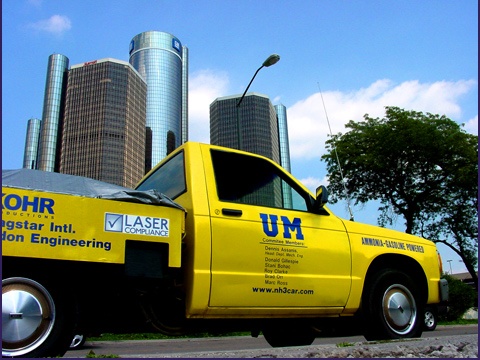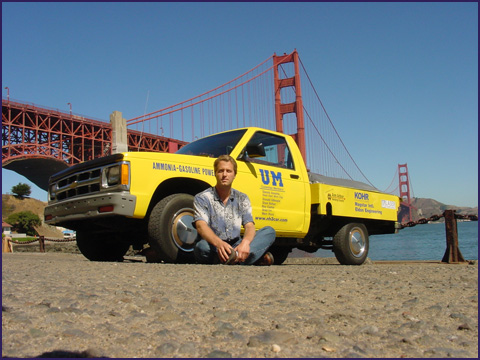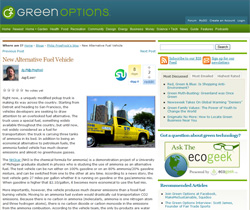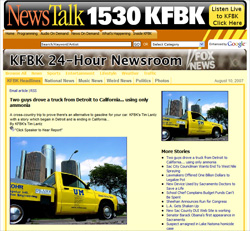


We departed from Detroit, MI on July 31st Click Here to follow along. 
|


Latest News
MISSION LOG 08.12.2007

Philip Proefrock contributing writer EcoGeek.org and GreenOptions.com
Right now, a uniquely modified pickup truck is making its way across the country. Starting from Detroit and heading to San Francisco, the vehicles developers are seeking to draw attention to an overlooked fuel alternative. The truck uses a special fuel, something widely available throughout the country, but until now, not widely considered as a fuel for transportation: the truck is carrying three tanks of ammonia in its bed. In addition to being an economical alternative to petroleum fuels, the ammonia fueled vehicle has much cleaner emissions and almost no greenhouse gasses. Read my full article here: Article
 MISSION LOG 08.10.2007 MISSION LOG 08.10.2007
Casey Stack was interviewed on News Talk 1530 KFBK in Sacramento.
Click the play button to listen to the 40 sec spot.
Tim Lantz
Reporter
KFBK - NewsTalk1530
MISSION LOG 08.01.2007
Casey Stack Reports: We Departed July 30th from Ann Arbor Michigan to Detroit Michigan’s Hart Plaza downtown. We set out on I-94 out of Detroit through Ann Arbor, through Kalamazoo all the way to about Gary Indiana, where we pick up I-80 west. Then west to the Wesyern border of Illinois and overnighted in Moline Ill. We then crossed the Mississippi Wed morning August 1st and into Iowa. We stopped in Des Moines Iowa to meet with reporters from the Des Moines Register (newspaper) ... They are preparing a large article on alternative fuels.
• Iowa is one of the largest producers of E85 Ethanol from Corn.
As of 6:30PM wed we are pulling into Omaha Nebraska, and will likely make North Platte Nebraska or Cheyenne very late tonight. (early Thursday) We will refuel the Ammonia tanks in Cheyenne Thursday morning.
We’ve been making great time with zero mechanical problems and issues to report.
Press Releases
Mr. Clean hits the road Ammonia-gas blend to fuel a drive to San Francisco
Wednesday, August 01, 2007
BY JO COLLINS MATHIS
News Staff Reporter
Those humps under the tarp in Shawn Grannell's pickup truck may look like lumber. But the Ann Arbor resident, who left Tuesday for California, is actually toting three tanks of ammonia.
That's right. The same pungent liquid you use to wash windows is - in a higher concentration and mixed about 60/40 in the carburetor with gasoline - fueling his way across the country.
"On the basis of either weight or volume, ammonia's the next best thing when liquid petroleum fuels can't be used,'' said Grannell, a University of Michigan doctoral student of applied physics. "I believe this is the only economically viable ... replacement for liquid petroleum fuels, especially for transportation use."
Grannell's thesis is on ammonia as an alternative fuel. But the idea of an ammonia-powered vehicle belongs to laser and holography pioneer Don Gillespie of Ann Arbor, the president of Eldon Engineering. For years, Gillespie has worked on issues related to global warming and the decline of petroleum.
After looking at the options from a chemistry and physics perspective, Gillespie determined that because ammonia has no carbon in its composition, burning it means the only exhaust is nitrogen and water vapor.
"If everybody went to (ammonia), we'd cut carbon dioxide emissions into the atmosphere by easily 65 percent,'' he said.
As an industry representative on Grannell's graduate committee, Gillespie persuaded Grannell to tackle the project and then advised him as Grannell converted a Chevy S-10 pickup into an ammonia-powered vehicle.
The truck is dual-fueled, meaning it can switch seamlessly from 100 percent gasoline fuel to a mixture of 80 percent ammonia/20 percent gas. He said the truck runs the same, no matter which fuel it's burning.
As far as the men know, it's the only vehicle powered by both gasoline and ammonia.
Casey Stack, business manager of NH3CAR, a company that's developing new technology and manufacturing conversion kits for cars to run on ammonia, is convinced that ammonia is the fuel of the future. He is accompanying Grannell to California on what largely amounts to a publicity campaign to create interest in the technology.
The truck gets 27 mpg whether running on gas or gas/ammonia. Stack said it becomes more economical to run a vehicle on ammonia than gasoline when gasoline is $2.10 a gallon. The drawback to ammonia, he said, is that there is no naturally occurring ammonia that can be mined.
"You pump oil out of the ground, but ammonia must be made from other energy sources,'' he said, noting that ammonia is plentiful, and the basis of fertilizers used in agriculture, but the infrastructure doesn't exist to distribute it,
The principal source of the energy for ammonia is natural gas, but ultimately the source of ammonia will be nuclear power, Gillespie said.
Enesta Jones, a spokeswoman with U.S. Environmental Protection Agency, said she couldn't speak on the specifics of what Gillespie and Grannell have created, but said their conversion makes them subject to the certification procedures of the EPA.
She declined to comment on the benefits of ammonia as fuel.
Hydrogen, battery-operated and electric fuel cell vehicles have a place in the alternative fuel market, but each has its limitations, Stack said. Ammonia hasn't yet caught on, said Stack, because of the "sheer inertia of the system."
"When industries are making hundreds of billions of dollars making something, they encourage more of the same," he said.
He said that for less than $1,000, future consumers may be able to convert their cars from gasoline to ammonia.
Automobile manufacturers can build cars that run solely on ammonia, but that would take several years.
Grannell and Stack expect their 930 pounds of ammonia to last until they get to Wyoming, where they've arranged to refuel.
Jo Mathis can be reached at jmathis@annarbornews.com or 734-994-6849.
|
P.S.T.

|





